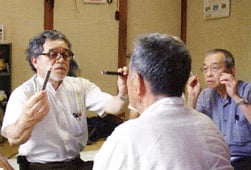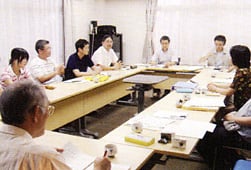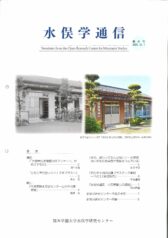The Open Research Center for Minamata Studies has been exploring Minamata Studies Projects, under which we pursue to develop the new academic discipline and methodology through clarifying the entire picture of the Minamata disaster, the “negative legacy”. It is selected and promoted as an Open Research Center Project for the Private Universities (with matching fund subsidy from the Ministry of Education, Culture, Sports, Science and Technology).
In the past, studies on Minamata disease and other environmental pollution cases were divided by the academic discipline and focused on a highly specialized topic. Learning from this reflection, we uphold the following five principles:
Project 1

 This project aims to reveal the truth of damages by Minamata disease through field-oriented survey and study. Working in close coordination with other two projects, we target not only the individual health impairment and disability but also the social extent of damages. In addition to the aspect of health hazard, we pursue more comprehensive research with perspective of the battered households and community and the impact on the local economy. The coverage of our investigation is expanding from Minamata and Ashikita regions to Izumi region and islands in the Bay. We also promote the research on Minamata Disease by younger generations.
This project aims to reveal the truth of damages by Minamata disease through field-oriented survey and study. Working in close coordination with other two projects, we target not only the individual health impairment and disability but also the social extent of damages. In addition to the aspect of health hazard, we pursue more comprehensive research with perspective of the battered households and community and the impact on the local economy. The coverage of our investigation is expanding from Minamata and Ashikita regions to Izumi region and islands in the Bay. We also promote the research on Minamata Disease by younger generations.
Project 2

 Based on the achievements in Project 1, the direction of community rehabilitation is sought for in collaboration with various local parties (such as administration, business, victims’ organizations, citizens/NPOs, Chisso employees, farmers, and fishermen) in order to establish the platform that can offer strategic policy propositions.
Based on the achievements in Project 1, the direction of community rehabilitation is sought for in collaboration with various local parties (such as administration, business, victims’ organizations, citizens/NPOs, Chisso employees, farmers, and fishermen) in order to establish the platform that can offer strategic policy propositions.
Taking the perspectives of the three elements of sustainability (environment, local economy, and social justice), we perform the empirical analysis on the current condition of the local community and environment disintegrated and exhausted by the Minamata disease disaster to propose the community rehabilitation model in Minamata and Ashikita Regions. At the same time, we aim to practice the participatory/active research study in order to advocate highly effective policies.
Project 3

 Aiming to make the most of the experiences from the Minamata disease case and avoid making the same mistakes again, we make available the results of Minamata studies widely and globally. Under this project, various materials such as Minamata disease litigation documents, administrative documentation, and research literature are currently acquired (totalling over 10,000 items), and more than 100,000 documents saved and stored at Shin Nippon Chisso Labor Union (the labor union of the company that caused Minamata Disease) are now being filed and organized. We also collect materials (documents, photos, diaries, etc.) kept at the houses of Minamata residents including patients and fishers through our field research works.
Aiming to make the most of the experiences from the Minamata disease case and avoid making the same mistakes again, we make available the results of Minamata studies widely and globally. Under this project, various materials such as Minamata disease litigation documents, administrative documentation, and research literature are currently acquired (totalling over 10,000 items), and more than 100,000 documents saved and stored at Shin Nippon Chisso Labor Union (the labor union of the company that caused Minamata Disease) are now being filed and organized. We also collect materials (documents, photos, diaries, etc.) kept at the houses of Minamata residents including patients and fishers through our field research works.
The materials and documents are filed and compiled into database, studied, and made open to public. We are now endeavoring to compile a comprehensive database of the Minamata studies literature covering a wide range of academic fields from medical science to legal study, sociology, and economics, to contribute to the future of Minamata studies both in Japan and abroad.







